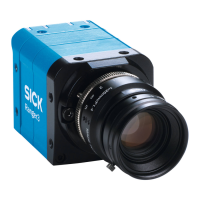The knee-point position and the slope after the knee-point are controllable by the Multi‐
SlopeMode parameter in the camera. There are three pre-defined parameter settings
(soft, medium and aggressive) which correspond to different amounts of compression.
These settings result in a dynamic range increase of approximately 2, 6 and 15, respec‐
tively. See figure 17.
0
0 500 1000 1500 2000 2500 3000 3500
Light intensity 2
Pixel value 1
50
100
150
200
250
3
4
5 6
Figure 17: HDR settings for Ranger3
1
Pixel value
2
Light intensity
3
Linear (non-HDR) mode
4
Soft pre-set
5
Medium pre-set
6
Aggressive pre-set
In HDR mode, the sensor readout must be finished before a new exposure can start.
The minimum cycle time is the sum of the exposure time and the readout time. In linear
mode, the sensor readout and a new exposure can be done in parallel.
For example: If the readout time is 33 μs and the exposure time is 30 μ, the total cycle
time is 33 μs for linear mode and 63 μs for HDR.
For information about how to enable HDR imaging for Ranger3, see "Enabling HDR
imaging", page 59.
7.11
Triggering
Triggering is used to control the initiation and rate of data acquisition. Different trigger‐
ing concepts and modes are presented below.
See "Setting triggering parameters", page 60 for information about how to activate
triggering and set the parameters in the user interface.
7.11.1 3D triggering concepts
Different application types require different triggering concepts. Below is a table of the
most common triggering situations.
Continuous flow No photoelectric switch is used.
Profiles are sent continuously to the PC, typically
arranged in frames of at least a few hundred pro‐
files.
Examples: Crushed stone, grain, sawdust.
CONFIGURATION 7
8020774/14IM/2019-07 | SICK O P E R A T I N G I N S T R U C T I O N S | Ranger3
31
Subject to change without notice

